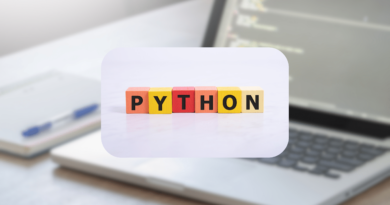Machine Translation: Historical Process, Quality Evaluation, and Brief Info on a Study in the Context of Türkiye
Machine Translation: Historical Process, Quality Evaluation, and Brief Info on a Study in the Context of Türkiye
Historical Background
From the past to the present, machine translation (MT) has seen an increase in demand and an expansion of its application. The definition of machine translation, its historical background, methods for assessing its quality, and their significance in relation to the Turkish language will be covered here.
The concept of machine translation dates back to the 17th century, yet actual steps in the field were not taken until the invention of computers in the middle of the 20th century. During that period, famous philosophers such as Descartes, Mersenne, and Leibniz considered the potential of employing numerical codes to facilitate universal communication. The lack of advanced technology at the time, however, precluded these ideas from progressing beyond the theoretical stage. The enormous advancements in computing technology and the growing demand and necessity for machine translation drove scholars to carry out new studies in the 20th century. Rule-based strategies were utilized in the beginning. However, it was not possible to have consistent and reliable outputs due to the intricacy of these methods and their inability to adequately capture the underlying structure of languages. Later, techniques for statistical machine translation were brought out. By utilizing vast datasets, these algorithms sought to get beyond restrictions based on grammatical constraints. After years of statistical systems dominating the field of machine translation, a novel system utilizing neural networks has become quite popular. The advent of the neural-based machine translation system (NMT) by Google in 2016 has made a radical revolution in the field of machine translation. Personally, I do not find it wrong to call this new system as the updated and amalgamated version of statistical machine translation in that it also uses large sets of bilingual corpora with the combination of neural networks. Furthermore, the main aim of Google was to reduce the deficiencies of statistical systems with the use of neural networks. They did not fail, indeed. The dominating performance of NMT set the bar too high and pushed other companies to use neural-based systems as well. By utilizing artificial intelligence (AI) and deep learning approaches, NMT systems are now
experiencing even further improvements in their performances. As a result, the outputs of MT systems have higher degrees of accuracy and naturalness.
Methods for Evaluating Quality
Evaluating the quality of machine translation systems is a very important process. These systems will be much more effective if the usability and accuracy of the results are determined, and improvements are implemented based on the findings. The two basic methods for evaluating quality are automatic and human evaluation.
In order to evaluate the translation quality, linguists or experienced translators conduct human evaluations with the use of a particular error analysis guide (such as MQM) as a point of reference. These assessments take into account a variety of fundamental error issues, including those related to accuracy, fluency, consistency, meaning, and style. In general, human review is argued to yield better results. It takes a lot of time and money, though. On the other hand, while automatic metrics are quicker and less expensive, they may produce inaccurate data. The hybrid strategy, which combines the two approaches, is therefore thought to produce the best outcomes.
The Turkish Context
As mentioned above, Google launched NMT systems in 2016. They made a point of stating in their release that their new technology only supported eight languages. What about Turkish? Was it included? The answer is yes. Turkish was included as one of the supported languages by this new system. This highlights the importance of the Turkish language and the amount of content generated in this language.
So, where does this significance of Turkish in the context of machine translation lead the researchers in translation studies? Of course, it pushes us to carry out studies on quality assessment. Unfortunately, there is a significant gap on evaluating the quality of machine translations in the context of Turkish. So, the question is how well different MT systems work in Turkish-English and English-Turkish translation processes. Under the supervision of Asst. Prof. Muhammed BAYDERE at Karadeniz Technical University, I conducted a BA graduation thesis project last year that was supported by the TUBITAK 2209 program focusing on machine translation error analysis and the quality evaluation. field of translation.
In this study, we compared how well Google Translate (GT), Yandex. Translate (YT), and Microsoft Translator (Mt) translated culinary texts embedded with culture-specific items in the Turkish-English and English-Turkish language pairs. For this reason, two Turkish and two English culinary texts were selected from a blog on Instagram. Then, these texts were translated in the three mentioned translation engines. After that, 12 gathered outputs were annotated based on the MQM error categories of accuracy, fluency, and style by three human annotators who have 10 years of experience in the field of translation.
Findings Overall
The study’s findings revealed that the performance of the aforementioned translation engines varied significantly. Comparing GT to the other two translation engines, it produced significantly better outputs. On the other hand, Mt and YT performed quite similarly. Yet, YT performed slightly better than Mt (see figure 1).
Figure 1. Total Errors
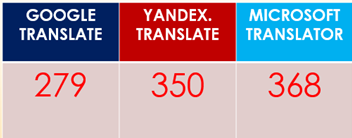
Total Error Distribution
In terms of fluency, accuracy, and style, GT significantly outperformed YT and Mt.
Mt outperformed YT in terms of fluency and style, yet YT performed better than Mt in terms of accuracy. Additionally, YT provided more accurate translations even though Mt created more fluent translations than YT.
Figure 2. Total Error Distribution
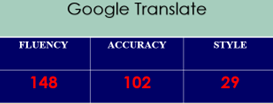
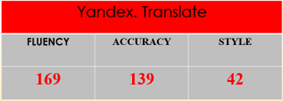
Findings on English-Turkish Texts
In their translation of culinary texts from English into Turkish, GT had the best performance, YT became the second best and Mt became the poorest. The most detected error is fluency, the second one is accuracy, and the last one is style with only one error. What does that mean? This means that the aforementioned Mt systems had the most difficulties in producing fluent Turkish translations while translating culinary texts from English to Turkish. Furthermore, they had also a significant difficulty in translating completely accurate outputs. The fact that they had little to no difficulty translating culturally specific aspects (style) is significant and rather interesting.
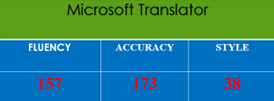
Figure 3. En-Tr Error Distribution
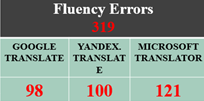


Findings on Turkish-English Texts
It should come as no surprise that GT once again demonstrated the best performance in the Tr-En translation as well. Yet, Mt outperformed YT to take over second place. It’s interesting to note that YT’s performance in Tr-En translation was not worse than it was in En-Tr translation. However, Mt performed in such a better way as opposed to its performance in the En-Tr pair that it helped Mt to outperform YT. Therefore, this change in the ranking of best performance can be attached to the significant performance of Mt in Tr-En translation.
In relation to error types, accuracy appeared to be the most detected, which was followed by fluency, and style errors were the least encountered ones. This finding suggests that these MT systems produce outputs in the Tr-En language direction that are noticeably more fluent than those in the En-Tr language direction. However, with 210 accuracy mistakes in En-Tr translations and 204 in Tr-En translations, there appears to be minimal difference in accuracy. Personally, the most notable difference between Tr-En and En-Tr translations of the aforementioned MT systems is that the frequency of style errors has significantly increased in the Tr-En translation. There was only one style error discovered in En-Tr texts, while there are 109 in Tr-En texts (see figure 3 & 4). This data reveals that in the Tr-En translations of culinary texts, MT systems experienced greater difficulties in finding the correct equivalent of culture-specific elements.
Figure 4. Tr-En Error Distribution

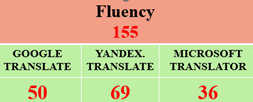
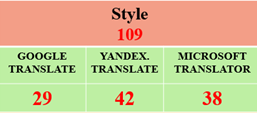
Overall…
This study successfully highlighted the strengths and weaknesses of GT, YT, and Mt in translating culinary texts in the language pairs of Tr-En and En-Tr. Thus, it achieved its goal of evaluating the performances of these MT systems and providing a significant data to the translation literature. It is essential to carry out studies on the quality of machine translation systems, which are used by millions of people every day, and to improve their performance with the findings gathered from these studies. Understanding these systems that we depend heavily on will not only reduce our costs but also enable us to use our time more efficiently. Therefore, expanding these studies in the Turkish language, where there is a great amount of content production, will be beneficial and fruitful for all of us.




